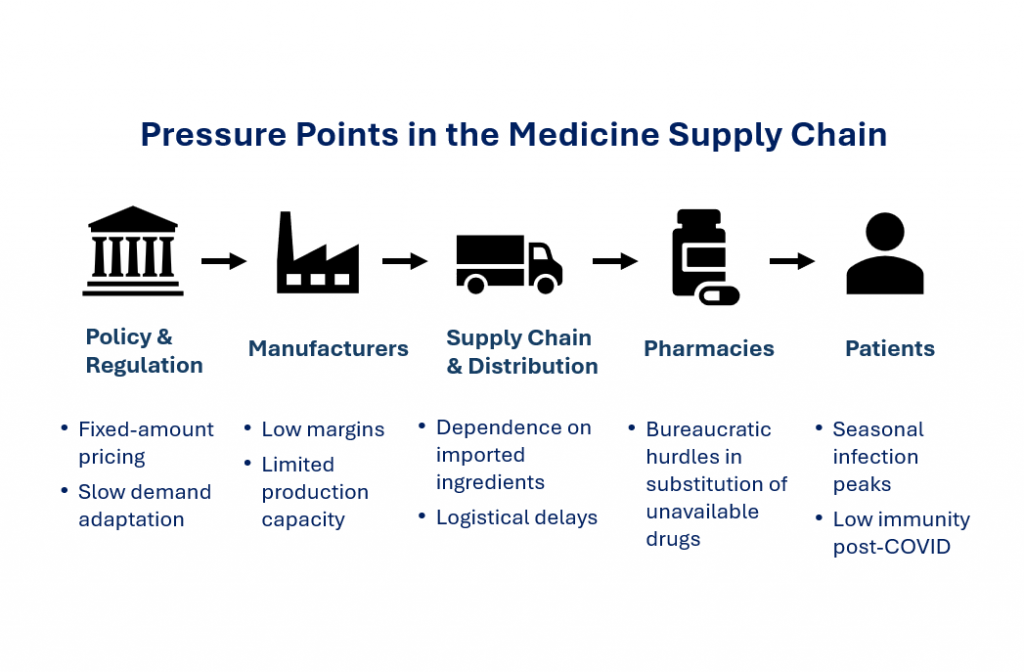In recent years, Germany has faced shortages of essential medicines for children, including antipyretics and antibiotics.
To encourage manufacturers to increase production and supply, the GKV-SV (GKV-Spitzenverband, German SHI association) has suspended fixed prices (Festbeträge) for over 750 medicines since November 2023. These measures were part of a broader reform in 2023, which also allowed pharmacists to substitute medicines that are not available without having to consult the prescribing physician. The suspension of reference prices was based on a list of essential pediatric medicines, updated regularly, as well as an urgency list published by BfArM, which highlights medicines under supply pressure.
For medicines with suspended fixed prices, price increases of up to 50% above the previous price are permitted. However, manufacturers of products without a fixed price must now grant a mandatory 6% discount, in turn reducing the financial benefit. Moreover, many manufacturers have left their prices unchanged; as the market remains highly competitive, the first company to raise prices risks losing market share. Furthermore, 76 medicines have already returned to the fixed amount system in the last two years. Since reference pricing can be reintroduced anytime, manufacturers cannot rely on pricing freedom, which might limit their willingness to invest in increased production capacity.
One example is the fixed price group Amoxicillin 2, which was suspended in November 2023. Of the 19 comparable medicines, only four experienced a price increase between November 2023 and November 2025. Nevertheless, the prices of nine medicines remained unchanged, and six were even priced lower than before.
Despite the actions taken by the government, the situation remains challenging. On November 4th of 2024, the urgency list included 312 products; one year later, the number remains at 300.
If the challenges still persist – How could the situation be improved?
Shortages are not limited to Germany. Other European countries are dealing with similar problems, the most affected substances being antipyretics such as ibuprofen and paracetamol as well as the antibiotic amoxicillin. Pediatric care depends on a small number of key medicines, and demand for them rose sharply when respiratory illnesses surged after lifting COVID-19 restrictions in 2022/2023. Although the problem already arose before the pandemic.
The causes are multifactorial: seasonal infection waves, prescription patterns, production and distribution hurdles, and pricing or procurement structures all contribute. Pediatric medicines are often economically unattractive, giving manufacturers little incentive to expand production. Europe’s growing dependence on imports from India and China for active ingredients further limits flexibility in times of crisis.

Challenges in different steps of the medicine supply chain in the context of pediatric drug shortages.
Whether suspending fixed amounts will bring sustainable relief to the pediatric market remains uncertain. The risk of products returning to the original price within months might impair manufacturers’ willingness to invest in production. Germany’s pharmacists’ association continues to call for long-term, effective measures to ensure supply security. Several steps have already been taken in this direction, and many will need to be maintained or expanded:
- Proper counseling of parents by pediatricians and pharmacists to avoid unnecessary drug treatment
- Improved vaccinations against common viruses to prevent diseases
- Availability of various formulations and package sizes of the same drug to avoid waste by tailoring dispensed quantities individually
- Monitoring of stocks and stronger stocking obligations
- Optimized, demand-responsive distribution of medicines
Addressing this problem will require investment, yet persistent shortages are hardly cost-neutral either. Unnecessary doctor visits and parents staying home with sick children are just two examples of how medicine shortages place an added strain on the healthcare system, families and workplaces. Substitutions of unavailable drugs can drive up treatment costs, and pharmacists spend valuable hours each week managing shortages instead of focusing on patient care.
For pharmaceutical companies, this represents both a challenge and an opportunity. The need for reliable pediatric medicines is undeniable, but meaningful progress will depend on whether this segment can once again become economically viable.
Sources: Magendie et al. 2024, Vogler 2024, Tagesschau (2025)